Dane Rudhyar (1895-1985) was one of the most important members of a group of American composers who called themselves the “ultramoderns.” He was a founding member of both the New Music Society, which was headed by the American-born Henry Cowell, and the International Composers’ Guild, which was led by the French-born Edgard Varèse. In a number of ways, Rudhyar’s music represents a synthesis of the approaches of Cowell and Varèse, both of whom were seminal figures in American modernism. Like Cowell, Rudhyar spent much of his life living in California. He also shared Cowell’s interest in Asian music and philosophy. Like Varèse, on the other hand, Rudhyar was a native of France and drew upon European influences in the formation of his musical style.
Born Daniel Chennevière in 1895 in Paris, Rudhyar received a basic musical education there but did not pursue advanced conservatory studies. He chose instead to immerse himself directly in the Parisian musical scene, which was particularly vibrant in the years leading up to World War I. Along with many other memorable performances, he attended the legendary Paris première of Stravinsky’s Le Sacre du printemps. His fist concert reviews were published when he still a teenager. He also had privileged access to the library of musical scores belonging to the Durand publishing house. Durand published a monograph he wrote on the music of Debussy, in which he commented on the whole of Debussy’s output up to that time, ending with the Préludes Book II and Jeux. Durand also published three of Rudhyar’s early piano pieces.[1]
With his imagination ignited by the music of Debussy, Stravinsky, and others, Chennevière (who had by now begun to refer to himself as Rudhyar) took on more ambitious compositional projects, including some orchestral music for a multimedia project by dancer and performance artist Valentine de Saint-Point. Saint-Point’s project, Métachorie (Beyond the Dance) was performed in Paris and also at the Metropolitan Opera House in New York. For the New York performance, Rudhyar travelled by boat with Saint-Point and lighting designer Vivan Postel du Mas. The performance, which took place in April 1917, was conducted by Pierre Monteux and was well reviewed. It did not, however, lead to the kinds of future performance opportunities for which Saint-Point had hoped, due in part to American involvement in World War I.
Late in 1917, Rudhyar separated from his Parisian associates, citing personal and ideological differences.[2] While Saint-Point and both of her assistants shared interests in esoteric philosophies, later developments in the lives of Saint-Point and du Mas pointed toward a right-wing orientation that was at odds with Rudhyar’s convictions, which were humanistic and transpersonal in nature, and therefore presupposed a good deal of individual freedom. From the beginning of his career, Rudhyar had been concerned with the social function of music. Soon after his departure from Paris, he expressed concern over what he saw as a turning away from the progressive nature of Debussy’s music in favor of a vapid and political irresponsible irony in some of the late music of Satie and in the music of Les Six.[3] A few years later, he came to associate neoclassicism with fascism.[4] In contrast to these tendencies, which he saw as reactionary and regressive, Rudhyar sought to move forward along the lines indicated by Debussy and Scriabin, in parallel with the future-oriented work of Varèse and Ruggles, among others.
The works on this recording constitute some of the most important piano music from Rudhyar’s first American period. This period, which lasted from 1918 to 1929, was musically among his most productive, and firmly established him as one of America’s most important modernists. Toward the beginning of this period Rudhyar composed a number of orchestral and vocal works, as well as chamber music and music for solo piano. Later on, he focused mainly on writing for solo piano. In an essay on his music written late in his life, Rudhyar stated that he considered the Four Pentagrams, the first eight Tetragrams, Paeans, and Granites to be his best known piano works.[5] Of these works, the Pentagrams, Paeans, and Granites are presented here, along with a slightly later work, Prophetic Rite.
The Pentagrams, written between 1924 and 1926, form a cohesive set and provide perhaps the best introduction to Rudhyar’s mature style. They feature colorful harmonies, dramatic contrasts, and expressive melodic lines. The first three Pentagrams were originally published in 1930 as Moments: 15 Tone-Poems for Piano. During the same period, Rudhyar composed a five-movement work for two pianos entitled The Human Way. In the 1970s, the first three Pentagrams were revised, with some simplification in the rhythmic notation and in the voicing of chords, and The Human Way was condensed into a work for piano solo and retitled as the Fourth Pentagram. Although the writing in the Fourth Pentagram is somewhat thicker, and its movements cross-reference one another more closely than in the previous Pentagrams, overall it forms a fitting conclusion to the set.
The First Pentagram is subtitled The Summons. Its first piece, The Call, is marked “With a powerful swing like the ringing of bells.” It divides into two sections, each of which begins with a syncopated bell-like figure, outlining a minor third. Each section attempts an ascent in register, the first of which tumbles precipitously into the low register, while the second succeeds in achieving a brilliant climax in which the upper and lower registers are unified. The second piece, Surging, is more reflective. It also achieves an intense climax, but in this case the climax occurs near the end of the middle section within an essential ternary formal plan. The third piece, Exultation, is the briefest in the entire set of Pentagrams. Some fifty years after it was originally composed, the opening of this movement would serve as the germ for the second movement of Rudhyar’s Crisis and Overcoming for string quartet (1978).[6] The fourth piece, Daughters of Men, like Surging before it, provides one of the First Pentagram’s expressive slow movements. The title appears to reference the mysterious tale of the intermarriage of the sons of God and daughters of men from Genesis 6. Replete with suggestions of forbidden human access to divine knowledge, this tale has long been a favorite of occultists, who associate with other Promethean myths from various cultures. The atmosphere of longing, passion, and solemnity that pervades this movement seems perfectly appropriate to its title. The title for the last piece, Breath of Fire, evidently refers to a yogic breathing technique whose apparent aim is to release the yogi’s awareness from its bondage to ordinary consciousness. Appropriately, the head of this movement is marked “With dyonisian intensity.” Its final gesture is a chord in the upper register, for which the performer is instructed to “cut sound sharply as chord is struck.”
The sharp contrasts of mood and tempo that characterize the First Pentagram are followed by a series of sustained, generally reflective moods in the Second Pentagram, whose subtitle is Enfoldment. Within the context of the entire set of Pentagrams, it functions in the manner of a large slow movement. The outer movements of the Second Pentagram, The Earth Pull and Salutation to the Depths, feature ascending and descending melodic thirds, as in The Call from the First Pentagram. Here, however, the context is solemn and introspective. The Earth Pull is marked “With the poignancy of autumns,” referencing a seasonal image favored by Rudhyar for the way in which it combines processes of decay along with the promise of renewal in the future. Salutation to the Depths is marked “Solemn and broad like the beating of gongs.” Its vivid evocations of metallic percussion look forward to the use of similar effects in the Third and Fourth Pentagram. The titles of the inner movements—Reaching Out, Tenderness, and Aphrodite (Born of the Foam)—suggest interpersonal relationship rather than solitary introspection. They contain some of Rudhyar’s most delicate and fluid writing.
The Third Pentagram, subtitled Release, is the one that is most frequently performed. It certainly stands strongly on its own, but certain of its characteristics gain in significance when it is heard following the previous two Pentagrams. Like the First Pentagram, the Third features an alternation of aggressive and reflective pieces. The first piece, Gates, evidently refers to a poem by the same name from Rudhyar’s collection Toward Man (1922-23).[7] The poem describes a journey from merely human love, through darkness and emptiness, toward Divine love:
Night of the soul,
when the first gates of love are left behind . . .
Night of the far-stretched wandering
that no beaconing light comforts . . .
— O child !
Do you not see glowing
the second gates of Love ?
A change from the “first” to the “second” gates appears to be expressed in a passage near the end of the piece during which the strident fanfares and gong-like effects of its beginning are left behind in favor of a slowly ascending succession of fifths. This passage, which defines a characteristic harmonic palette for the Third Pentagram as a whole, is shown in Example 1 below.
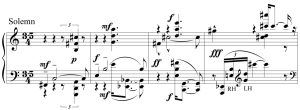
Example 1: Gates, mm. 16-19
The title of the second piece, The Gift of Blood, likewise references a poem from Toward Man. The poem is “A Song of the Woman,” which explores the theme of compassionate self-sacrifice, contains the lines, “The Heart of the World is so vast / that all men and souls live from Its gift of blood.” The piece, which is in ternary form, features reflective music in its outer sections and intense expression in its middle section. The third piece, Pentecost, is an intense and somewhat violent baptism by fire. Like Breath of Fire from the First Pentagram, it ends in the extreme high register. Stars, which is probably Rudhyar’s most accessible composition, is a lyrical nocturne in ternary form. As in The Gift of Blood, its more turbulent passages are reserved for its middle section. Sunburst, which shares some of its harmonic material with Stars, provides a brief but brilliant conclusion to the Third Pentagram. Example 2 shows the opening harmony of Stars, the concluding chords from Sunburst, and the concluding sonority from The Earth Pull from the Second Pentagram. In each case, the harmonies are derived from a cycle of perfect fifths that begins on C and proceeds as far as F#, as shown at the end of Example 2. Several examples of harmonies derived from cycles of perfect fifths may be found as well in the excerpt from Gates in Example 1.

Example 2: Harmonies derived from a cycle of perfect fifths in Stars, Sunburst, and The Earth Pull
Rudhyar continued to develop his harmonic language in the Fourth Pentagram. Here the cycle of perfect fifths is presented in its entirety, spanning a range of nearly seven octaves. As shown in Example 3, this occurs in the second piece, Yearning, and in the fifth, Peace. These cycles are related to one another by transposition by one whole step. These complete cycles each present all twelve chromatic pitch classes, thus forming instances of a configuration that Milton Babbitt referred to as the aggregate. A more gradual presentation of the aggregate occurs at the beginning of the first piece, Pomp, in which a partial cycle of fifths starting on C is accompanied by an enharmonically respelled F# major triad, an A major triad, and an A-flat major triad. This group of pitch classes forms a symmetrical ten-note collection that would later be named by Olivier Messiaen as the seventh of his modes of limited transposition. The remaining two pitch classes, B and F, occur in a gesture at the end of the second measure of this piece, thus forming the complete aggregate.

Example 3: Aggregate formation in Yearning, Peace, and Pomp
The placement of companion pieces in the Fourth Pentagram is different from that in the previous Pentagrams, and the cross-references between movements are more precise. The first piece, Pomp, consists mainly of march-like chordal figures and strident fanfares. These materials are mostly set, however, in asymmetrical meters such as 7/4 and 5/4 (the latter meter having been prominent also in Salutation to the Depths from the Second Pentagram, with which this movement shares some of its ambience). Toward the end of Pomp, the meters even out somewhat (to 9/4 and 6/4) and the harmonies become more diatonic. With its atmosphere of metallic brilliance, the conclusion of this piece resembles somewhat the end of Sunburst. Pomp’s companion piece is the fourth movement, Overcoming. This piece is turbulent until its final section, which presents a varied repetition of the opening of Pomp before leading to a grandiose conclusion of its own. The third piece, Irony, is a sarcastic romp that stands alone within the Fourth Pentagram and, in fact, within the series of Pentagrams as a whole. It is a sparkling, and thumping, scherzo that offsets the weightiness of the remaining pieces. The expressive slow pieces, Yearning and Peace, are the second and fifth movements, respectively. They share a similar atmosphere and they both make extensive use of open fifths, as indicated in Example 3 above. They also both make slightly veiled references to the opening of Wagner’s Tristan Prelude, indicated that this famous musical symbol of yearning was still very much alive in Rudhyar’s imagination. (Probably unknown to Rudhyar at the time, Alban Berg also made reference to the Tristan Prelude in the last movement of his Lyric Suite for string quartet, which was written at about the same time as the Fourth Pentagram.) Just before the references to Tristan in Peace, there is a passage marked “Intense, yet serene” that would reappear, transposed and slightly simplified, in the fourth movement of Rudhyar’s Third Tetragram, subtitled Rebirth (1927-28). Yet another connection with one of Rudhyar’s pieces occurs in Peace: its opening measures intone a rising and falling melodic third on C#-E-C#, the enharmonic equivalent of the D-flat-F-flat-D-flat motive at the beginning of The Call from the First Pentagram, in the very same octave. Thus, with Peace, the set of Pentagrams comes full circle. Characteristically for Rudhyar, however, it only does so in a transformed manner, having undergone an extensive journey from its point of origin to its point of return.
Paeans (1927) and Granites (1929) are the most easily available of Rudhyar’s works in print, but they do not necessarily present the most accessible introduction to his music. Both works had the good fortune to be published in Henry Cowell’s New Music periodical, in 1927 and 1935, respectively, and they were reissued as a single publication by Merion Music in 1972, with additional annotations by the composer. The Paeans were, in fact, dedicated to Henry Cowell. Written in Hollywood in early 1927, they feature jagged, dissonant melodic notes and short, concentrated rhythmic and melodic cells that are repeated in irregular patterns. While their title invokes ancient Greece, the nervous energy of these pieces seems rather to invoke the restlessness of a modern urban environment. This work, more than the Pentagrams, appears to reflect the influence of Rudhyar’s fellow countryman, Edgard Varèse, who famously portrayed the sonic environment of the modern urban landscape in his major orchestral work Amériques (1918-21, revised 1927). Chords in fifths appear near the end of the first piece, presented in contrary and parallel motion in staccato rhythms. This passage is followed by a coda that pulls downward linearly in the bass from G-flat, through E to a conclusion on a low octave D. The second piece, in addition to jagged melodic lines, contains a concluding passage marked “Mighty. Gong-like” that is centered in part around a B diminished triad. At the end of this piece the B diminished triad is underpinned by a low octave B-flat, as if to supply a functional dominant harmony for the E-flats that appear like a pedal point in various registers throughout the passacaglia-like third piece. This piece ends with gestures that suggest the crashing of gigantic waves, or the clashing of titanic opposing forces, somewhat similarly to the end of Varèse’s Amériques.
The image of crashing waves is appropriate to the opening and closing pieces of Granites as well, but the atmosphere of this work is different from Paeans. Composed in Carmel, California, Granites seems to reflect the local landscape, with its dramatic counterpoint of towering cliffs and rocky shore. This is a locality that also attracted the photographers Edward Weston and Morley Baer and the poet Robinson Jeffers, each of whom inscribed a sense of its mystery into his work. Written in two weeks in August of 1929, this is one of Rudhyar’s most concentrated compositions. Its textures are clearer than those in Paeans, featuring massive chords that are offset by spare two-part counterpoint, which is somewhat unusual for Rudhyar. Granites consists of five brief movements, which are more concise and more strongly interrelated than those found in the Pentagrams (although interrelations among the movements in the Fourth Pentagram are significant, as mentioned above). The end of the fifth movement references the melodic and harmonic profile of the first, while the opening theme of the slow, lyrical second movement is referenced in the middle of the third, which functions somewhat in the manner of a scherzo. The fourth movement is the most expansive and expressive, and contains some of Rudhyar’s most compelling music. Perhaps it is to read too much into Granites to see it as a musical prophecy of the “fiscal cliff” that would soon lead to the crash of the stock market and the beginning of the Great Depression, but yet there does seem to be something solemn and valedictory about the work that lends it a tragic dimension that is slightly more pointed than that of the preceding works, with the possible exception of Paeans. In any event, the Great Depression brought with it a drying up of the patronage that had allowed Rudhyar to compose as prolifically as he had in the 1920s. As a result, he turned his attention mainly toward writing and would not resume steady compositional activity until 1967, with only a few exceptions in the intervening years.
One of these exceptions is Prophetic Rite, which closes this disc. The chronology of this work is difficult to determine precisely. In its original version (which is recorded here), it was published as an autonomous work in 1950.[8] It subsequently reappeared in a revised version, entitled Oracle, as one of the four movements of Syntony (1967).[9] The style of Prophetic Rite anticipates that of Rudhyar’s late works, in which the power found in Paeans and Granites is generally somewhat restrained, thus signaling a return to the kind of color, drama, and lyricism found in works such as the Four Pentagrams. Nonetheless the combination of powerful chords and delicate contrapuntal writing found in Granites makes itself felt in this work, too. Prophetic Rite opens with a series of syncopated chords that are interspersed with dramatic fanfares. Harmonically it explores both chromatic and diatonic territories. Its overall formal design is ternary, but the organizational complexity the ternary design’s component sections—two distinct themes in the outer sections and a turbulent, developmental inner section—hints at the possibility of underlying sonata-form conception. This suggestion is offered cautiously, given Rudhyar’s general aversion to complexity of formal design.[10]
So far I have avoided the topic of the composer’s intentions with respect to the performers of, and listeners to, his music. The topic of intentions is territory on which it is dangerous to tread, but fortunately Rudhyar gave several public lectures on the nature of his music, a few of which have been preserved in audio recordings. The following remarks are excerpted from one such lecture, entitled “Dissonant Harmony,” delivered in Palo Alto, California in 1983:
“If you want to use the instrument [the piano] … to induce … resonances and to release a power of transformation through … awakening within the total psyche of another human being a similar resonance, which will also expand their consciousness in a cosmic sense, as it were, you have to … be able to maintain a psychic tension. The process must be maintained, and that’s the difficult thing in playing my music. … It is a sustained process. Living is a sustained process. … You are not duplicating or making concrete an art object which is there in a pattern. … You are managing … the unfoldment of a process, and that process will prove its value only … in what it does to the listener’s psyche. … Art does something to the person who is in front of it, or who is affected by it, or who is subjected to it, and its value is in what it does to that person. Of itself, it is merely a stimulant in some way. … If the performer needs psychic tension, the listener needs a real attention. The mind should be open to the process of basic renewal through the magic of sound. … Let the sounds do their magic in your open souls.” [11]
Rudhyar’s music is challenging, but also deeply rewarding. It should certainly occupy a more prominent place in the pianistic repertoire than it does, and the same can be said for his chamber and orchestral works. Although easily available commercial recordings of this music are relatively few in number, among the notable pianists who have contributed to the dissemination of Rudhyar’s work are William Masselos, Maro Ajemian, Marcia Mikulak, Richard Cameron-Wolfe, Steffen Schleiermacher, and Sarah Cahill. As these performers have inspired me to bring Rudhyar’s music before a wider public, it is hoped that the recordings presented here will inspire others to take up this challenge and to maintain a robust and continuous tradition of performance practice for this important stream within the legacy of American modernist music.
— Ron Squibbs
Ron Squibbs is Associate Professor of Music at the University of Connecticut at Storrs. His scholarly and performance activities center on the music of the twentieth and twenty-first centuries. His previous release for Aucourant Records is On the Keyboard: Piano Music of Joji Yuasa (AUREC-0501-1).
Web: www.ronsquibbs.com
Recorded September 9-11, 2011 on a Steinway D at Florence Kopleff Recital Hall, Georgia State University, Atlanta, Georgia
Recording engineer and producer: Robert S. Thompson
Piano technician: ________ _________
Cover art: Rudhyar, Meditation on Power (1948), watercolor. Courtesy of Leyla Rudhyar Hill.
Funded in part through a grant from the Aaron Copland Fund for Music, Inc., with additional support from the University of Connecticut School of Fine Arts Dean’s Grant Fund.
[1] These pieces may be heard in a performance by Sarah Cahill at http://radiom.org/detail.php?omid=NMS.2007.02.24.1.A. The second and third pieces have also been recorded by Richard Cameron-Wolfe on Paris-X: Musica Obscura of Dane Rudhyar and Erik Satie (Furious Artisans FACD6807).
[2] Dane Rudhyar, “An Illustrated Biographical Sketch,” Part 2. http://khaldea.com/rudhyar/bio2.shtml.
[3] Rudhyar D. Chennevière, “Erik Satie and the Music of Irony,” Musical Quarterly 5/4 (1919): 469-78.
[4] Dane Rudhyar, “Musical Fascism” (1922). http://khaldea.com/rudhyar/musicalfascism.html.
[5] Dane Rudhyar, The Magic of Tone and the Art of Music (Boulder: Shambhala, 1982), p. 193.
[6] This work was recorded by the Kronos Quartet on the album Dane Rudhyar: Advent, Crisis and Overcoming, Transmutation (New World NWCR604).
[7] Dane Rudhyar, Toward Man: Poems (Carmel, California: The Seven Arts, 1928).
[8] Dane Rudhyar, Prophetic Rite for piano (New York: Merrymount Music Press, 1950), currently available in a reprint edition by Theodore Presser.
[9] Dane Rudhyar, “Musical, Artistic, and Written Works.” http://www.khaldea.com/rudhyar/listofworks.shtml, does not list Prophetic Rite as an individual work, but states that Syntony contains revisions of works that were written between 1919 and 1934. The contrast between chordal and linear textures in Prophetic Rite suggests that it may have been written after Granites (1929), and therefore a date between 1929 and 1934 seems plausible.
[10] This aversion is stated in several places in his writings, including in The Magic of Tone and the Art of Music, cited above.
[11] Dane Rudhyar Audio Archives, Rudhyar Institute for Transpersonal Activity Conference 1983, A Musical and Artistic Interlude, Part 3, http://www.beyondsunsigns.com/rudhyaraudiorita83.html#selfact.






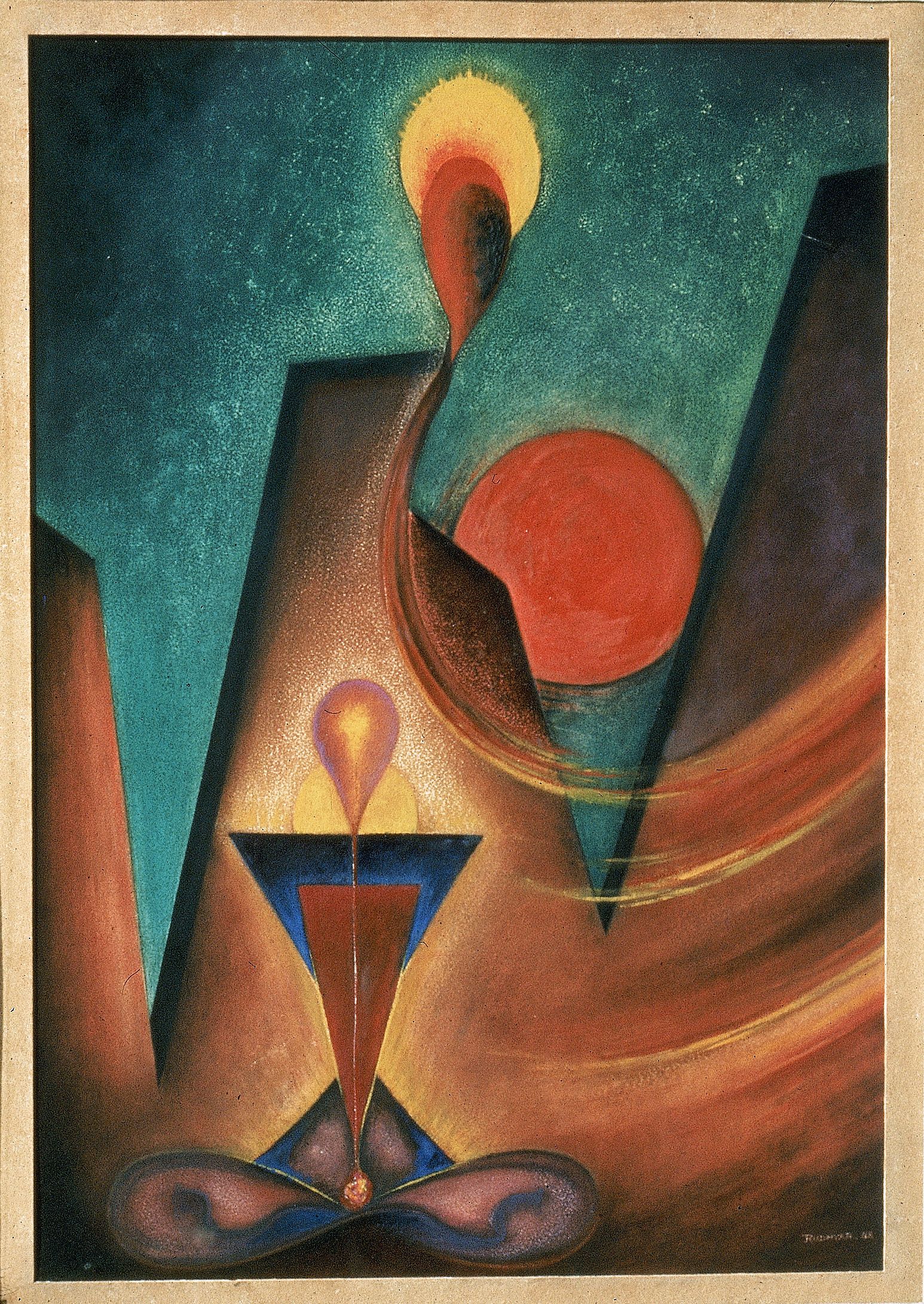
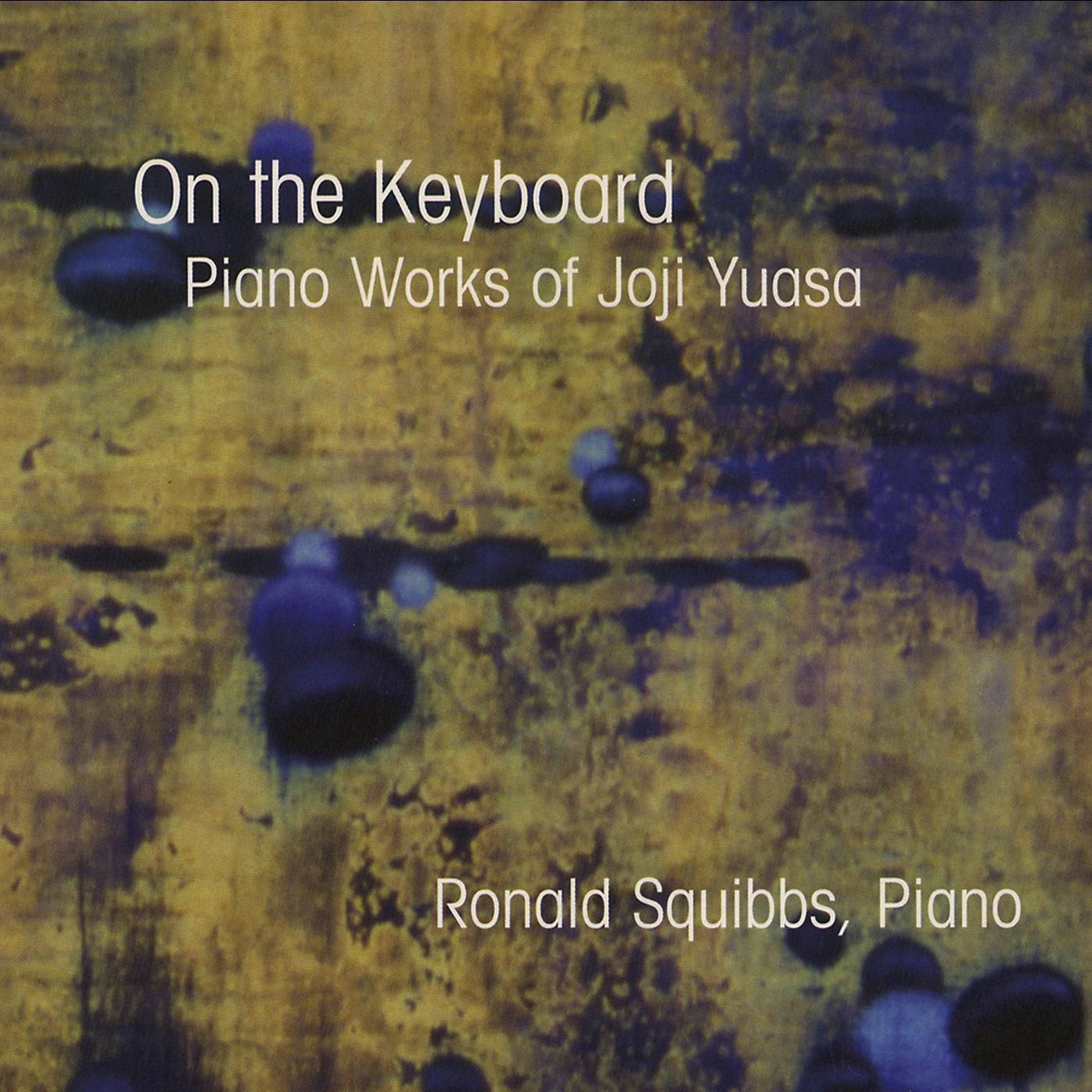
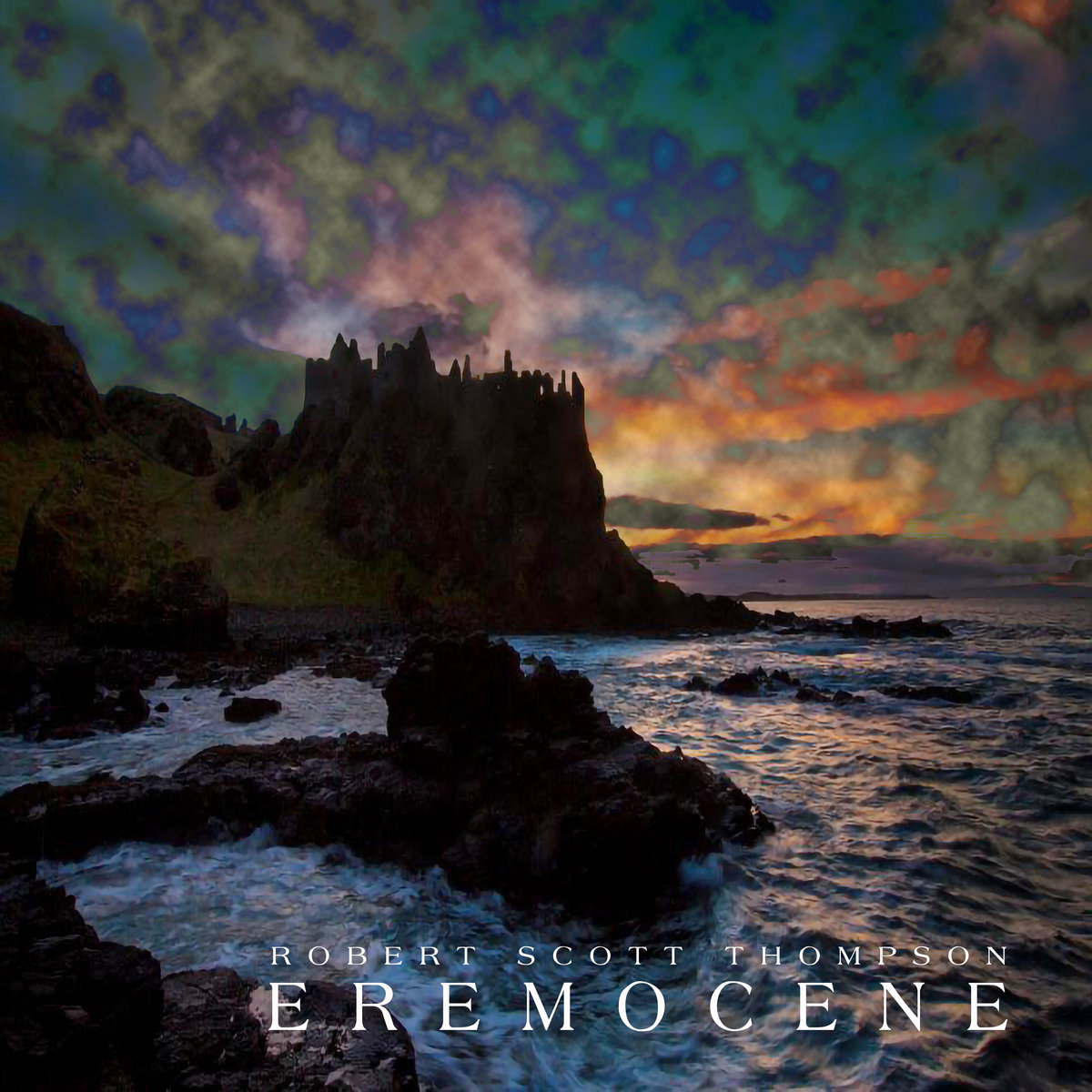
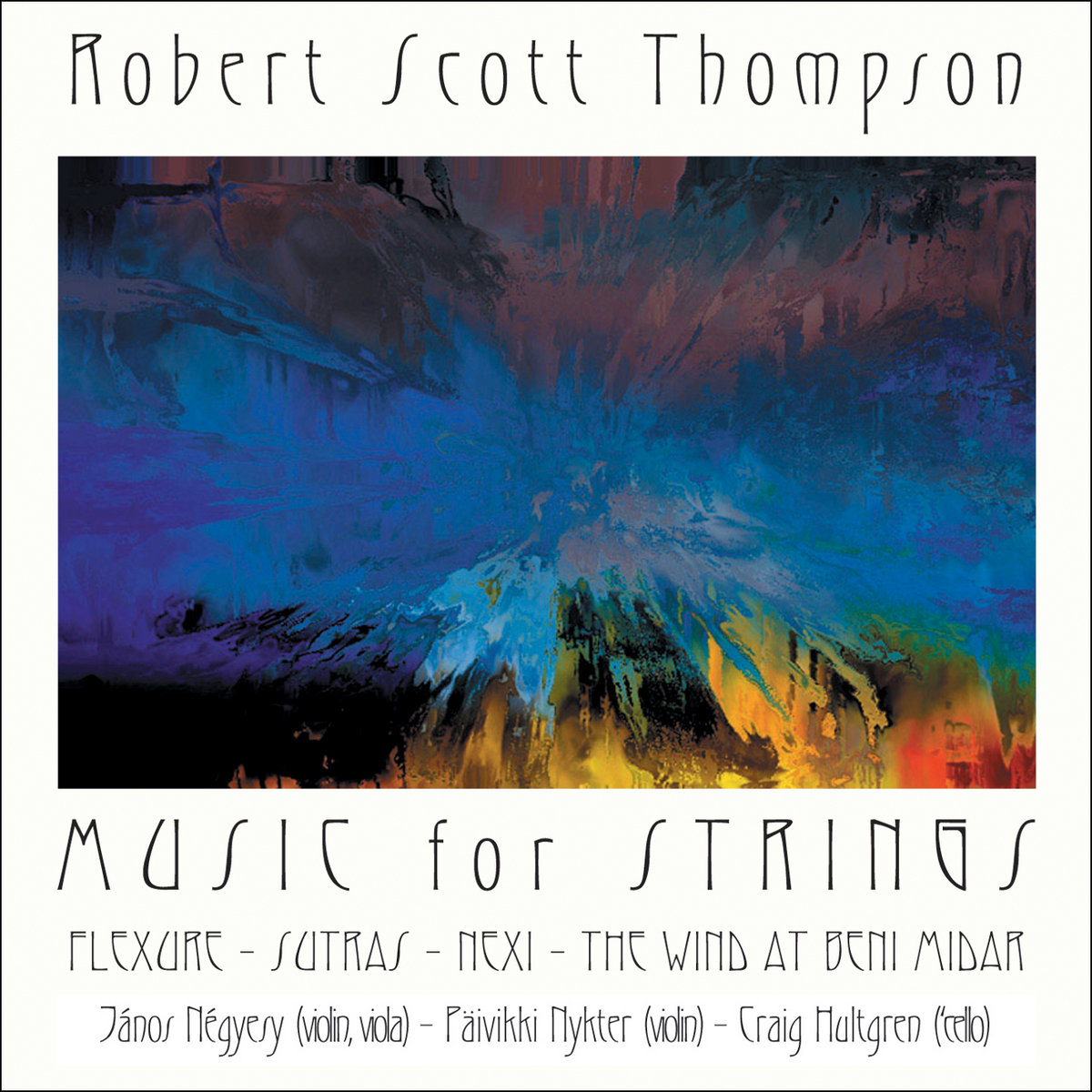
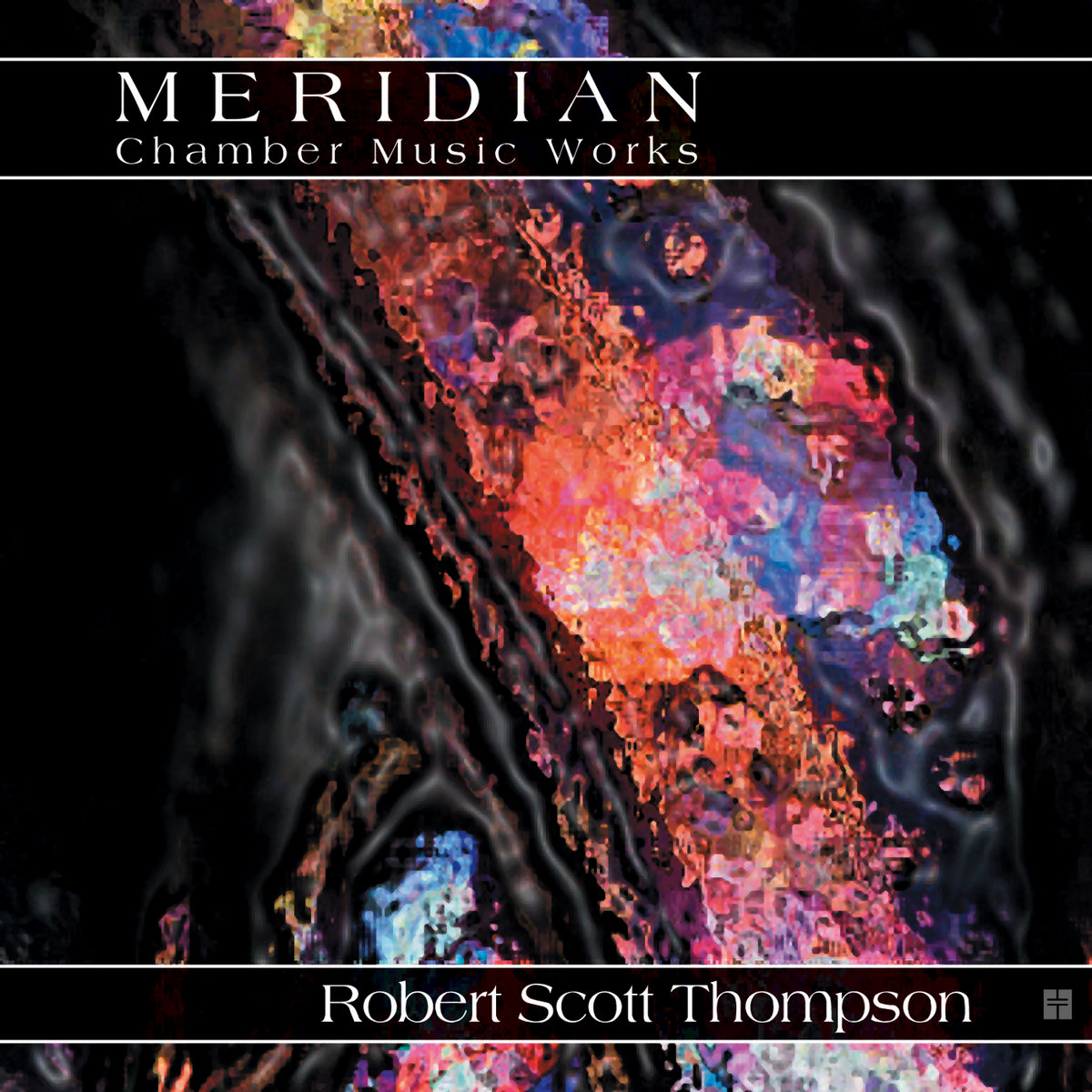
Reviews